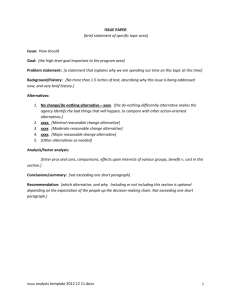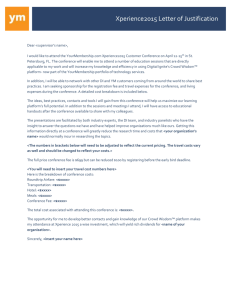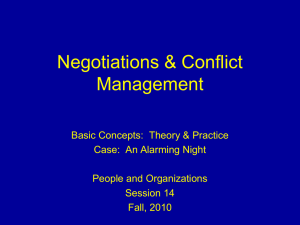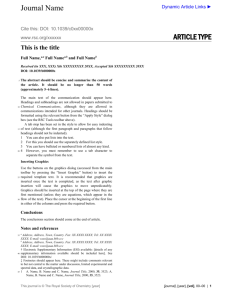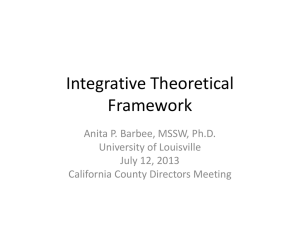CONFLICT RESOLUTION PROJECT PAPER RUBRIC (Week 5)
advertisement
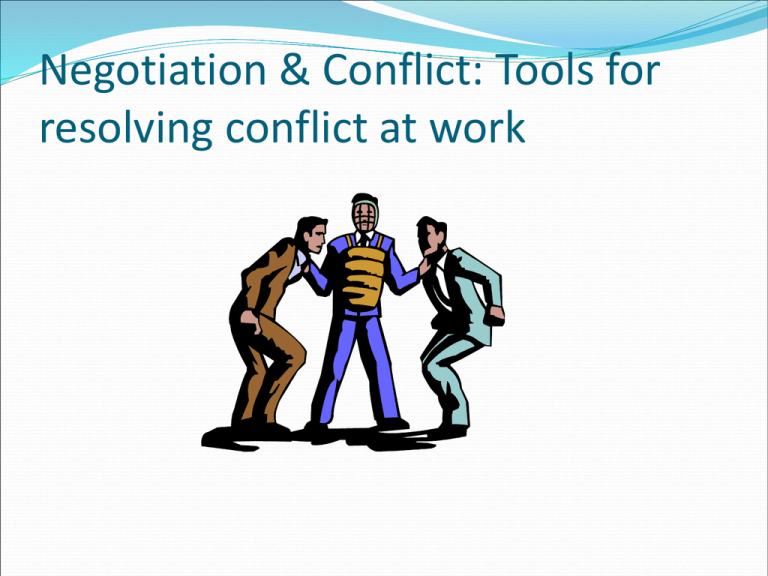
Negotiation & Conflict: Tools for resolving conflict at work CONFLICT RESOLUTION PROJECT PAPER RUBRIC (Week 5) Does the paper: Describe the conflict/issue? Identify the source/ triggers of the conflict? Perform an interests analysis? Assess the negotiation style and practices of the participants? Assess power and alternatives to a negotiated agreement? Consider diversity issues at play in the conflict/issue? Describe resolution and/or solution recommendations? Writing mechanics- punctuation, grammar, spelling, sentence structure. Evidence of research- scholarly journals, texts as well as properly cited and referenced in APA format. Organization of paper- well-structured introduction, body, summary and recommendations. Logical and smooth progression of ideas. Not all conflict is bad. Identifies strengths and weaknesses. Creates competitiveness, which can increase productivity. Identifies alternatives for resolution and improvement. Identifies new opportunities. Promotes growth. Promotes critical thinking. Responses to conflict Avoidance. Accommodation. Competition. Compromise. Collaborative. Two approaches Positional – demands, needs, & wants of one party. Interest-based – values, wants, & goals of each party. Preventing Conflict Providing meaningful work. Pay and benefits. Safety. Redress. Tolerance and respect. Clear expectations. Communication. Resources – training, equipment, time, et cetera. Triggers Role identification – are we working toward the same ends? Working at cross-purposes? (Marketing v. Production v. Delivery) Information – Johari Window Relationships – interpersonal, stereotypes, diversity. Values – importance of work v. family. Structures – power imbalances, silos, & dumping. Bumps, Bruises, & Head bangers Bumps – disagree, but maintain normal relationship. Ordinarily no immediate action required by Mgt. Bruises – evolving conflict that involves some sort of intervention before it escalates and damages relationships. Requires preventative action by Mgt. Head bangers – the battle is on. Requires immediate attention. Rights Based Approach to Conflict Laws & Regulations (EEOC, FMLA, FLSA, et cetera). Company policies and procedures. Contracts and Labor Agreements. Competitive design. Interest Based Approach Focus on needs, values, & wants of each party. Acknowledges demands, but looks for true interests. Tries to understand the “Why” of a dispute. Collaborative design. Distributive v. Integrative Distributive –adversarial bargaining. Only so many apples; every apple you get, I get one less. Integrative – interest based. Apple sauce. Variables Importance of outcome v. the importance of relationships. Communication Nonverbal – body language, facial expressions, and gestures. Verbal – words we use. Para-verbal – how we say things, pitch, speed, tone, and inflections. Listening Not hearing – inattentiveness. Hearing content – literal message. Hearing feeling – emotions, passion. Therapeutic listening – help others gain insight into their patterns of thought and behavior. Paraphrasing and empathetic responses. Communication Continua Solution Giving---------------------Problem Inquiry ( Don’t worry about it) (What is going on?) Superiority--------------------------Equality (I told you so) (We can work it out) Ignore Feelings----------------------Empathy (Oh, stop it!) (I feel XXXX, when XXXX) Absolute------------------------------Conditional (Never, always, absolutely) (Maybe, perhaps, not sure) Evaluate-------------------------------Descriptive (Too many meetings) (Meeting at 9:00 AM) Supportive Confrontation ID problem ownership. Research & Reflect. Select alternative (3 alternatives rule). Change your attitude, change your environment, or confront the conflict. Rehearse. Meet to resolve. Follow through and follow up. “I “Messages Engage in conversation and not a sell job. 2. Eliminate anger. 3. Use I messages. I messages are used to disclose to the other person how you honestly feel about something. “I feel XXXX when you XXXX.” 1. Integrative Negotiation Problem solving. Mutual benefits. Interest-based. Recognizes that the most wise, efficient, and durable agreements depend on open communication among cooperating, trusting parties who explore alternatives for mutual gains while preserving relationships. BATNA Best Alternative To a Negotiated Agreement (BATNA). To what do you aspire (best outcome)? What would make you content (satisfies your basic need). What could you live with (acceptable). Causes of Impasse A party’s needs and interests have not been met at the appropriate level or depth. A party has made a take-it-or-leave-it statement and does not want to lose face. No agreement on defining the problem. Parties are stuck on two proposals, one each advocated by the parties. A party does not want to take responsibility for a proposed agreement. A party does not believe the proposal is achievable. A party is stubborn, overwhelmed, or fearful. Achieving Consensus 1. 2. 3. 4. 5. 6. 7. 8. Communicate the problem & agree on a problem statement. Allow all to express views. Brainstorm solutions. Narrow list of proposed solutions. (feasible, legal, and ethical) Select a solution. Develop an implementation strategy. Evaluate. Celebrate when the problem is solved. Assertive Confrontation Describe Behavior. Explain the Impact. State the Desired Change. Empathize if you can. Invite Options for Resolution. Choose a Consequence. Check for Understanding and Compliance. Opportunistic Employee Fails to take responsibility for unsatisfactory behavior. Resents & resists authority. Shifts blame. Presses to gain every advantage. Concocts theories and stories to explain why he is being treated “unfairly.” Engages in manipulative behaviors to escape or avoid consequences. Threatens legal action. Managing the Opportunistic Employee Don’t hire! “No amount of training can make up for a bad hire.” Job task analysis, SKAs, references, et cetera. Probationary period. Know your policies, procedures, & disciplinary rules. Prepare for the long haul. Lengthy process. Assertive confrontation. Document behaviors, bring unacceptable behaviors to the person’s attention and praise good behaviors. Keep your cool. Be professional and dispassionate. Do not try to be the person’s friend. When you discipline, it will seem like you betrayed your friend and only make matters worse. Written performance improvement plan. Questions?
